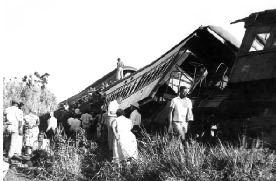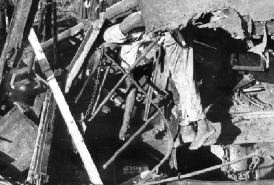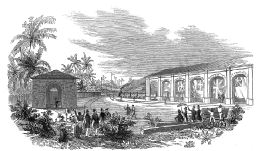|
Tragedy
at Kendal - 1957
The
worst rail disaster in Jamaica's history, and the second worst rail disaster
in the world at that time.
On
Sunday, September 1, 1957, hundreds of members of
the
Holy Name Society of St. Anne's Roman Catholic Church boarded a train
at
the Kingston Railway Station for an all day excursion to Montego Bay under
the
guidance
of their pastor, the Reverend Father Charles Earle.
Also
on board were close to 100 known criminals, hooligans and pickpockets.
In all the number of passengers totalled 1600 an interesting feat
given that the limit for each of the 12 cars was 80. The criminals were
said to have caused such a ruckus during the trip that a priest declared
that the wrath of God had surely descended on them.
Unknown
to him, that statement was prophetic. At around 11:30 p.m. on the train's
return leg, as the two diesel engines and dozen wooden cars neared the
sleeping town of Kendal, Manchester, three shrill whistle blasts signalled
the journey's abrupt and tragic end. Within minutes, the train had picked
up speed and derailed. Fragments of human bodies were strewn among scores
of twisted
metal. Close to 200 persons lost their lives, and 700 sustained injuries
in what was described as the worst rail disaster in Jamaica's history,
and the second worst rail disaster in the world at that time.
Word
travelled fast and hundreds flocked to the scene only to be greeted with
the sight of corpse after corpse laid out on an embankment, looking, in
the words of a survivor, like bundles of dirty clothes.
The
cause of the accident was later determined to be
the accidental closure of an angled wheel (brake) cock that had been placed
incorrectly. Some survivors reported that many of the hooligans had ridden
on the platforms and steps and some had tampered with that angle cock
while en route to Montego Bay. Others indicated they had seen the wheel
in question tightened in Montego Bay. While neither of these accounts
could be confirmed, some things were known for sure. The train was overcrowded
- there were 130-150 passengers per car. Confidence in the rail service
was shaken and much looting and robbing of the dead and injured occurred
after the crash. The ensuing investigation found a number of deficiencies
among the Jamaica Railway Corporation. Regarding the train in question
- the general standard of maintenance of the brake equipment was deemed
unsatisfactory.
 
Left
photograph:
Survivors and spectators picking their way through and around the wreckage
of three telescoped coaches.
Right photograph:
A body hangs limp from the wreckage of a rail car. Police later said
this man was on their 'most wanted' list.
Jamaica's
Railway History

- In 1845, the Illustrated
London News (pictured above) described the JRC's ceremonious opening
on November 21 of that year in detail. On that morning, the first leg
Kingston to Spanish Town was opened at approximately 11:30
a.m by then colonial governor, the Earl of Elgin and attended by numerous
influential colonists as well as members of the general public climbed
aboard. The 10 carriage train pulled out of the Kingston terminal to
the sounds of the 1st West India Regiment, beginning the first railway
excursion in the British West Indies.
- The £222,250
railway, a feat of engineering, was built soon after the first public
railway in England, making it one of the first in the world. It owed
its development to two pioneers, William and David Smith, merchant/landowner
and planter respectively.
- In 1869, the Spanish
Town to Old Harbour extension opened, but the greater part of Jamaica's
railway was constructed between 1885 and 1896 Spanish Town to
Ewarton (1885), Porus to Montego Bay (1894) and Bog Walk to Port Antonio
(1896).
- In 1879 the railway
system was taken over by the government for a 10 year period before
it was sold to an American syndicate for £800,000. By 1900, the
American company, having lost money due to low receipts, turned the
system back over to the government.
- In the 1920s a
one-way train ticket from Spanish Town to Kingston cost a total of 3
shillings, 6 pence. Travel in a 5 seater motor car cost 1 shilling,
6 pence per mile or 21 shillings.
-
On
July 30, 1938, 32 people lost their lives and over 70 were injured
in Balaclava headed from Kingston to Montego Bay. An engine jumped
the rails and embedded itself firmly into the mountainside, followed
by coaches which when forced on from the rear, piled themselves one
on top of the other, orchestrating chaos and death.
-
In
the 1950s dieselisation occurred, reducing operating costs and increasing
passenger comfort. However, the cost of moving freight by rail in
Jamaica was still listed as among the highest in the world
the system's operating deficit was in the region of £300,000.
-
By
the 1970s, the railway extended for 333 km (224 1/4 miles) with the
principal connections being Kingston and Montego Bay in the north-west,
and Kingston and Port Antonio in the north-east, with a junction at
Spanish Town.
-
Today,
the Government is conducting discussions with a team from the Rail
India Technical and Economic Service (RITES) regarding the long-delayed
resumption of the national rail services. The first phase, commuter
services, between Kingston and Spanish Town then Kingston to Linstead,
was expected to be up and running by January 2001 but there have been
delays. The initial investment required for the first phase is set
at US$8 million. The Government is said to be considering an initial
40 per cent shareholding, to be used for improving infrastructure,
loading stock and the purchase of new trains.
-
Having
run for over 150 years, the railway ceased operation in 1992 except
for sections on which bauxite is drawn.
-
Throughout
the railway's history it provided a means of transportation for people
of many races and classes, it afforded more people the chance to engage
in islandwide travel and because of the relatively low rates, more
people from lower socio-economic classes were able to participate.
Sources:
Clarke, C. G. (1974). Jamaica in Maps. London: Hodder & Staughton
Educational, Cundall, F (1923) Handbook of Jamaica. Kingston: Government
Printing Office, Johnston J. (1903) Jamaica, the New Riviera. London:
Cassell and Co. Ltd, The Jamaica Railway Corporation. The Railway in Jamaica,
1845-1870 - A Short History. Kingston : JRC.
|
| Feedback
To the Series |
|
"I have
found your articles on the Pieces of the Past most entertaining
and interesting to read. For me as a historian these pieces come
at a time when Jamaicans need to reconnect themselves with their
past and the Gleaner's efforts through this medium is quite commendable.
I have found
especially today's article on the 1780 hurricane to be quite of
interest to me as I am currently involved in bringing to light the
role of natural disasters in the development of Jamaica's history,
culture, society, economy and politics and the article on the "Hurricane
of 1780" has greatly aided in this direction. Keep up the good
work and I look forward to more interesting and historically significant
pieces from this series." - Kerry-Ann
|
| The
First 500 years in Jamaica |
|
We're
taking you for a stroll down memory lane for the next six
months. Along this journey,we will relive several events which
significantly impacted on the social, political and economic
development of Jamaica. As we travel share your experience
with us...
Send your comments to:
Pieces
of the Past,
The Gleaner Company Ltd.,
7 North Street, Kingston;
E - mail us: editor@gleanerjm.com
Fax 922-6223.
|
|
|



